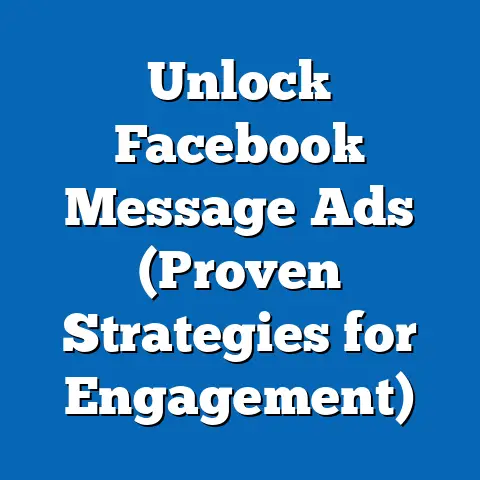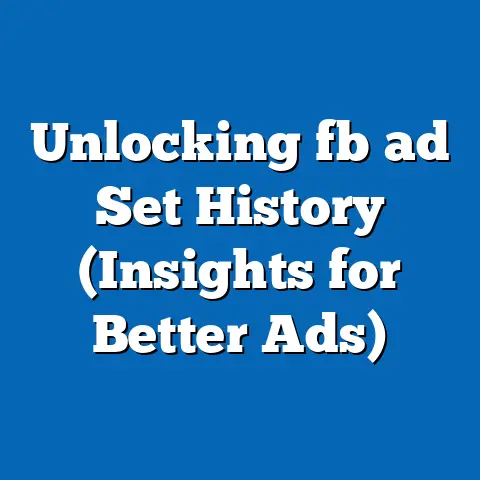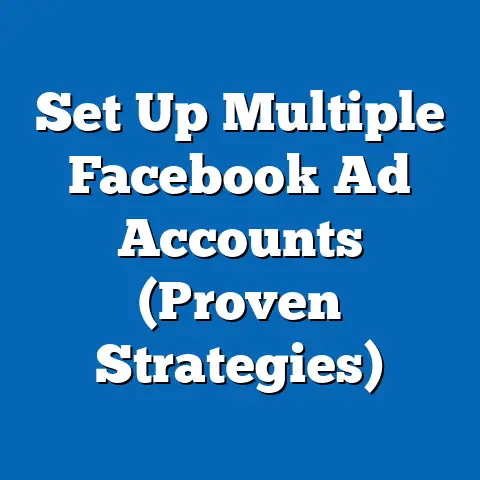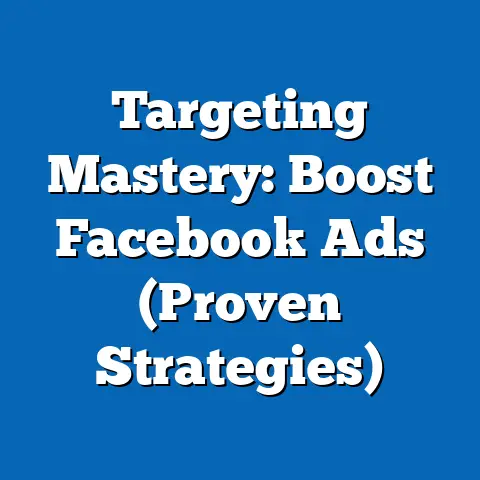Can You Use PayPal for Facebook Ads? (Essential Guide)
Digital advertising has become a cornerstone of modern marketing, with platforms like Facebook leading the charge. In 2022, global digital ad spending reached $567 billion, and it is projected to grow to $701 billion by 2025, according to eMarketer. Within this landscape, Facebook Ads remains a dominant force, with over 10 million active advertisers as of 2023, per Meta’s own reports, and a user base of 2.9 billion monthly active users.
A significant trend shaping this space is the demand for flexible payment options. Small businesses, freelancers, and individual advertisers—demographics that make up a substantial portion of Facebook’s ad ecosystem—often seek accessible and secure payment methods like PayPal. Data from Statista shows that PayPal had 435 million active accounts worldwide in 2023, with a particularly strong presence among millennials and Gen Z, who represent 48% of its user base. This overlap with Facebook’s key advertising demographics raises an important question: Can you use PayPal for Facebook Ads?
Section 1: Understanding Facebook Ads Payment Systems
How Facebook Ads Payments Work
Facebook Ads operates on a pay-per-impression or pay-per-click model, where advertisers are charged based on the performance of their campaigns. Advertisers must set up a payment method in their Facebook Ads Manager to cover these costs, which can be prepaid or postpaid depending on the region and account settings. The platform typically requires a primary payment method to be linked to the account before campaigns can run.
Payments are processed through the Ads Manager, and Meta supports a variety of methods, including credit cards, debit cards, and in some cases, digital wallets. The system automatically charges the linked payment method when a predefined spending threshold is reached or at the end of a billing cycle. This structure ensures seamless transactions but also raises questions about which payment options are universally accepted.
Official Payment Methods Supported by Meta
According to Meta’s official Business Help Center (updated as of October 2023), Facebook Ads supports a range of payment methods, but their availability varies by country and currency. Common options include Visa, MasterCard, American Express, and direct bank transfers in select regions. PayPal is listed as a supported payment method in over 70 countries, including the United States, United Kingdom, Canada, and Australia, but it is not universally available.
Meta specifies that PayPal can only be used if the advertiser’s account currency matches the currency associated with their PayPal account. For instance, a U.S.-based advertiser with a USD PayPal account can use it for Facebook Ads, but mismatches (e.g., a USD PayPal account with an EUR ad account) may result in rejection. This policy reflects Meta’s focus on minimizing currency conversion issues and fraud risks.
Historical Context: Evolution of Payment Options for Facebook Ads
When Facebook Ads launched in 2007, payment options were limited to credit and debit cards, catering to a smaller pool of advertisers. By 2012, as the platform’s user base grew to over 1 billion, Meta began integrating alternative payment methods to accommodate diverse markets, particularly in regions with lower credit card penetration. PayPal was introduced as an option in select countries around 2015, aligning with the platform’s push to attract small businesses and solo entrepreneurs.
Historically, digital wallets like PayPal have gained traction due to their ease of use and security features. A 2018 report by Worldpay noted that digital wallets accounted for 21% of global online transactions, a figure that rose to 29% by 2022. For Facebook Ads, integrating PayPal was a strategic move to tap into this growing payment trend, though regional restrictions persist due to regulatory and operational challenges.
Section 2: Can You Use PayPal for Facebook Ads?
Direct Answer: Yes, But With Limitations
For example, in the United States, where PayPal holds a 22% share of digital wallet transactions (per Statista 2023), advertisers can seamlessly link their PayPal accounts to Facebook Ads. However, in countries like India, where local payment systems such as UPI dominate (with a 40% market share per NPCI data), PayPal is not always a supported option for Facebook Ads due to regulatory constraints.
Step-by-Step Guide to Adding PayPal as a Payment Method
If PayPal is supported in your region, follow these steps to add it to your Facebook Ads Manager:
- Access Payment Settings: Log into your Facebook Ads Manager and navigate to the “Billing & Payments” section under “Settings.”
- Add a New Payment Method: Click on “Add Payment Method” and select “PayPal” from the list of available options.
- Link Your PayPal Account: You will be redirected to PayPal’s login page to authorize the connection. Ensure your PayPal account has sufficient funds or a linked funding source.
- Confirm Currency Match: Verify that the currency of your PayPal account aligns with your ad account’s currency to avoid transaction failures.
- Set as Primary Method: Once linked, you can set PayPal as your primary payment method for automatic billing.
Meta notes that processing times for PayPal transactions may vary, and occasional delays (up to 24 hours) can occur during verification. Advertisers are advised to monitor their account for any declined payments, which may result from insufficient funds or PayPal account restrictions.
Regional and Demographic Variations
The availability of PayPal for Facebook Ads highlights significant regional disparities. In North America and Western Europe, where PayPal usage is high (with 79% of U.S. online shoppers using PayPal, per a 2022 PYMNTS report), integration with Facebook Ads is widespread. Conversely, in regions like Africa and parts of Asia, where mobile money platforms dominate (e.g., M-Pesa in Kenya with over 50 million users), PayPal support is limited or absent for ad payments.
Demographically, PayPal’s integration appeals strongly to younger advertisers and small business owners. A 2023 survey by Morning Consult found that 62% of Gen Z and millennial entrepreneurs prefer digital wallets over traditional banking methods for business transactions. This demographic, which constitutes 35% of Facebook’s advertising base (Meta, 2023), benefits most from PayPal’s availability, though access remains uneven globally.
Section 3: Advantages and Disadvantages of Using PayPal for Facebook Ads
Benefits of Using PayPal
- Security Features: PayPal offers robust buyer and seller protection, reducing the risk of fraud. With over 70% of users citing security as their primary reason for using PayPal (Statista, 2023), this is a significant advantage for advertisers wary of sharing card details directly with platforms.
- Ease of Use: Linking a PayPal account to Facebook Ads is straightforward, and funds can be managed from multiple sources within PayPal, such as bank accounts or credit cards.
- Global Reach in Supported Regions: For advertisers in supported countries, PayPal provides a familiar and widely accepted payment option, facilitating cross-border transactions without the need for international credit cards.
Drawbacks and Limitations
- Regional Restrictions: As previously noted, PayPal is not available for Facebook Ads in all countries. This excludes a significant portion of advertisers, particularly in emerging markets where digital ad spending is growing fastest (projected to increase by 15% annually in Asia-Pacific, per eMarketer 2023).
- Currency Matching Issues: Even in supported regions, currency mismatches can prevent PayPal from being used. This is a common frustration for advertisers operating in multiple markets.
- Transaction Fees and Delays: While Facebook does not charge extra for using PayPal, PayPal itself may impose fees for currency conversions or withdrawals (up to 4% per transaction in some cases). Additionally, payment processing delays can disrupt ad campaigns, especially for time-sensitive promotions.
Comparison to Other Payment Methods
Compared to credit cards, which are accepted universally on Facebook Ads, PayPal offers enhanced security but lacks the same level of accessibility. Direct bank transfers, available in select regions, are often slower (taking 3-5 business days) but may be cheaper for large transactions. Mobile payment systems like Apple Pay or Google Pay are emerging alternatives, though their integration with Facebook Ads remains limited to specific markets as of 2023.
Section 4: Historical Trends in Digital Payments for Advertising
Growth of Digital Wallets in Advertising Payments
The adoption of digital wallets for online advertising payments has surged over the past decade. In 2015, only 12% of global online transactions used digital wallets, a figure that climbed to 29% by 2022, according to Worldpay’s Global Payments Report. PayPal, as a pioneer in this space, has been instrumental in driving this trend, with transaction volumes growing from $235 billion in 2015 to $1.36 trillion in 2022 (PayPal Annual Report).
For platforms like Facebook, integrating digital wallets was a response to advertiser demand for flexibility. By 2018, over 30% of small business advertisers on Facebook reported a preference for non-card payment options, per a survey by Statista. This shift was particularly pronounced among younger demographics and in regions with high mobile penetration.
Current Data vs. Historical Benchmarks
As of 2023, digital wallets account for approximately 35% of payment methods used by small and medium-sized businesses (SMBs) for digital advertising, a significant jump from 15% in 2017 (eMarketer). PayPal remains a top choice, though competitors like Stripe (used by 18% of SMBs) and local systems are gaining ground. On Facebook specifically, PayPal’s usage as a payment method has stabilized at around 20% of supported accounts, reflecting its niche but critical role.
Historically, credit cards dominated ad payments, with over 80% of transactions in 2010. Today, their share has dropped to 60% as alternative methods proliferate. This diversification reflects broader trends in e-commerce and consumer behavior, where convenience and security are paramount.
Section 5: Demographic Insights and Preferences
Who Uses PayPal for Facebook Ads?
PayPal’s user base for Facebook Ads aligns closely with its broader demographic profile. According to a 2023 Pew Research Center report, 58% of PayPal users are under 35, with a strong skew toward urban and tech-savvy individuals. Within the context of Facebook Ads, small business owners and freelancers—categories that represent 40% of advertisers (Meta, 2023)—are the most likely to opt for PayPal due to its accessibility and lack of credit requirements.
Gender differences are minimal, though men are slightly more likely to use PayPal for business transactions (52% vs. 48% for women, per Statista). Income levels also play a role, with middle-income advertisers (earning $30,000-$75,000 annually) comprising 45% of PayPal users on the platform, reflecting its appeal to budget-conscious businesses.
Regional Demographic Patterns
In the U.S., where 85% of online businesses accept PayPal (PYMNTS, 2022), its usage for Facebook Ads is highest among Gen Z and millennial entrepreneurs, who value digital-first solutions. In Europe, particularly in the UK and Germany, PayPal usage mirrors this trend, with 65% of small businesses citing it as a preferred payment method for online tools. In contrast, regions like Southeast Asia show lower adoption due to the dominance of local wallets like GrabPay and GoPay, which cater to 70% of digital transactions in the area (Bain & Company, 2023).
These patterns underscore the importance of localized payment solutions for global platforms like Facebook. While PayPal serves a critical demographic, its reach is constrained by regional payment ecosystems and cultural preferences.
Section 6: Data Visualization Description
To illustrate the trends discussed, imagine a multi-layered chart titled “Payment Methods for Facebook Ads by Region (2023).” The chart would feature a world map with color-coded regions indicating PayPal availability for Facebook Ads (green for supported, red for unsupported). Overlaying this would be bar graphs in key regions (e.g., North America, Europe, Asia-Pacific) showing the percentage breakdown of payment methods used: credit cards (60%), PayPal (20%), bank transfers (10%), and others (10%).
A second visualization, a line graph titled “Growth of Digital Wallet Usage in Digital Advertising (2015-2023),” would plot the increasing adoption of digital wallets globally, with specific callouts for PayPal’s transaction volume milestones ($235 billion in 2015 to $1.36 trillion in 2022). These visuals would help readers grasp the geographic disparities and historical shifts at a glance, reinforcing the data-driven insights provided.
Section 7: Alternatives to PayPal for Facebook Ads
Credit and Debit Cards
For advertisers unable to use PayPal, credit and debit cards remain the most reliable option. Accepted in virtually all regions, cards like Visa and MasterCard account for 60% of Facebook Ads transactions globally (Meta, 2023). They offer immediacy and broad compatibility, though security concerns and credit limits can be drawbacks for some users.
Bank Transfers and Local Payment Systems
In regions where PayPal is unsupported, direct bank transfers are often available, particularly for larger advertisers. These are slower—taking 3-5 days to process—but are cost-effective for high-volume spending. Local payment systems, such as UPI in India or iDEAL in the Netherlands, are also integrated in specific markets, catering to 25% of advertisers in those areas (eMarketer, 2023).
Emerging Digital Wallets
Newer digital wallets like Apple Pay, Google Pay, and Stripe are gradually being integrated into Facebook Ads, though their availability is limited as of 2023. Apple Pay, for instance, is supported in only 15 countries for ad payments, per Meta’s documentation. These options may expand in the future, reflecting the ongoing shift toward mobile-first payment solutions.
Section 8: Broader Implications and Future Trends
Implications for Advertisers
The partial availability of PayPal for Facebook Ads highlights a broader challenge in digital advertising: the need for inclusive payment systems. Small businesses and individual advertisers, who drive 50% of Facebook’s ad revenue (Meta, 2023), benefit from options like PayPal, but regional disparities create barriers. This can limit market entry for advertisers in unsupported areas, potentially stunting growth in high-potential regions like Africa and South Asia.
Future of Payment Integration
Looking ahead, the trend toward digital wallets and localized payment systems is likely to accelerate. Industry forecasts suggest that by 2027, digital wallets will account for 50% of online transactions globally (Worldpay, 2023). For Facebook, expanding PayPal support and integrating other wallets could enhance accessibility, particularly as competition from platforms like TikTok (with 1.5 billion users and growing ad revenue) intensifies.
Broader Economic and Cultural Shifts
The integration of PayPal and similar systems also reflects deeper shifts in economic behavior. As cashless economies grow—over 60% of transactions in the EU are now digital, per ECB data—advertising platforms must adapt to diverse payment preferences. Cultural factors, such as trust in digital systems (higher in North America than in parts of Latin America, per Pew Research), will continue to shape adoption rates, influencing how platforms like Facebook prioritize payment options.
Conclusion: Navigating Payment Options for Facebook Ads
Using PayPal for Facebook Ads is a viable option for many advertisers, particularly in supported regions like the U.S. and Europe, where it aligns with the preferences of younger, tech-savvy demographics. However, limitations such as regional restrictions and currency requirements mean it is not a universal solution. By understanding Meta’s payment policies, exploring alternatives like credit cards and local systems, and staying informed about emerging trends, advertisers can optimize their payment strategies.
The broader implications of this topic extend beyond individual convenience to the inclusivity of digital advertising ecosystems. As digital wallets like PayPal grow—projected to handle half of all online transactions by 2027—platforms must balance global reach with local relevance. For now, advertisers are encouraged to verify PayPal availability in their region through Facebook Ads Manager and prepare contingency payment methods to ensure uninterrupted campaigns. This adaptability will be key in a rapidly evolving digital marketplace.






